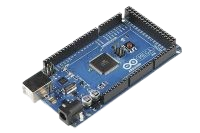Arduino Mega 2560

The Arduino Mega 2560 is a microcontroller board based on the ATmega2560 chip,
designed for projects needing a large number of input/output (I/O) pins and more processing power compared to smaller Arduino boards like the Uno.
It's a versatile platform for various applications, including robotics, 3D printing, and projects requiring extensive hardware connections.
Key Features:
ATmega2560.
Digital I/O Pins: 54 (15 with PWM output).
Analog Input Pins: 16.
Memory: 256KB flash memory (8KB used by bootloader), 8KB SRAM, and 4KB EEPROM.
Clock Speed: 16 MHz.
USB Host Chip: MAX3421E.
Power: 5V operating voltage, 7-12V recommended input voltage, and 6-20V input voltage limits.
Programming: Uses Arduino IDE (Integrated Development Environment).
Compatibility: Designed to be compatible with most shields for Arduino Uno, Diecimila, and Duemilanove.
Physical Dimensions: Length: 101.98 mm, Width: 53.63 mm, Height: 15.29 mm.
Uses: Ideal for projects requiring many I/O pins, more memory, and higher processing power than other Arduino boards like the Uno.
Target Applications
Robotics:
The Mega 2560's high processing capacity and numerous I/O pins make it suitable for controlling multiple motors and sensors.
3D Printing:
It can handle the complex algorithms and customization needs of 3D printing projects.
Wi-Fi Integration:
The Mega 2560 is compatible with Wi-Fi shields, allowing for wireless functionality in various applications.
Additional Information
- The Mega 2560 is a successor board to the original Arduino Mega, providing a larger set of I/Os compared to the traditional Arduino Uno
- It's often recommended for projects requiring extensive I/O, more sketch memory, and more RAM.
- The board is powered by a USB cable or a DC power jack.

